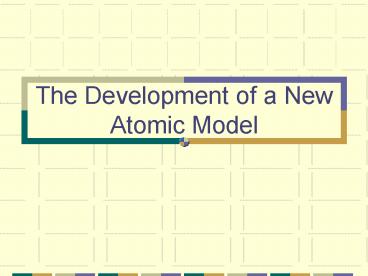The Development of a New Atomic Model PowerPoint PPT Presentation
1 / 16
Title: The Development of a New Atomic Model
1
The Development of a New Atomic Model
2
Objectives
- Explain the mathematical relationship between the
speed, wavelength, and frequency of
electromagnetic radiation. - Discuss the dual-wave particle nature of light.
- Discuss the significance of the photoelectric
effect and the line-emission spectrum of hydrogen
to the development of the atomic model. - Describe the Bohr model of the hydrogen atom.
3
Links
- http//www.quantumintro.com/
- http//newton.ex.ac.uk/research/qsystems/people/je
nkins/mbody/mbody2.html
4
A New Model Was Formed
- Why wasnt the positive nucleus attracted to the
negative electron cloud? - Investigations into light led to understanding of
relationship between light and electrons. - Led to revolutionary theory about the nature of
light, matter, and atoms
5
Properties of Light
- Electromagnetic spectrumall forms of radiation
exhibit wavelike behavior as they travel through
space. - ?-rays (gamma), X-rays, ultraviolet, visible
light, infrared light, microwaves, radio waves - Travel at 3.0 x 108 m/s
6
(No Transcript)
7
Waves
- Wavelength? (lambda)distance between crests of
adjacent waves (nanometers 1 nm1 x 10-9 m) - Frequency? (nu)the number of waves that pass a
given point in one second (Hzhertz) - Speed of lightwavelength is inversely
proportional to frequency - c ? ?
8
Photoelectric Effect
- Electrons are given off from a metal when light
of a certain frequency is shined on it - If light is a wave, light of any frequency should
make electrons be given off - ??why only certain frequencies??
9
Light as Particles
- Max PlanckGerman physicist1900
- Proposed that objects give off energy in small,
specific amounts - Quantumminimum quantity of energy that can be
lost or gained by an electron
http//nobelprize.org/physics/laureates/1918/planc
k-bio.html
10
Albert Einstein
- Electromagnetic radiation is both a wave and a
particledual wave-particle nature - Light has wavelike properties
- Light can behave as a stream of particleseach
particle with a quantum of energy - Photonsparticle of electromagnetic radiation
having zero rest mass and carrying a quantum of
energy - Amount of energy depends on frequency
http//www-groups.dcs.st-and.ac.uk/history/PictDi
splay/Einstein.html
11
Line-Emission Spectrum
- Ground statelowest energy state of an atom
- Excited statestate where an atom has higher
potential energy - Neon signcurrent passes through a gas at low
pressure and is excitedwhen it returns to ground
state it gives off energy as electromagnetic
radiation
http//www.neonsign.com/brands/index.html?itemrea
dy
12
Line-Emission Spectrum
- When light from an excited state atom is passed
through a prism, it is separated into a series of
specific wavelengths (not all like a rainbow) - When an atom falls back from excited state to
ground stateit gives off a photon of radiation - Led to Quantum Theory
13
Line-Emission Spectrum
- Specific lines in spectrum mean that the energy
differences between energy states was fixed - Electrons exist only in specific energy states
Animation of H line spectrum
http//www.glencoe.com/sites/common_assets/science
/cmc/cim/animations/ch5_1.rm
14
http//www.quantumintro.com/
15
Bohr Model
- Neils BohrDanish physicist1913
- Linked model of atom with the emission spectrum
- Electrons can only travel in specific paths
(orbits) - Electrons in an orbit have a fixed amount of
energy - Orbits closest to nucleus have smallest energy
http//nobelprize.org/physics/laureates/1922/bohr-
bio.html
16
Bohr Model
- Atoms gain energy electrons move to higher
orbits (excited state) - As electrons fall back to lower energy orbits
they give of photons with a fixed amount of
energy - Amount of energy photon has is seen as lines in
emission spectrum

